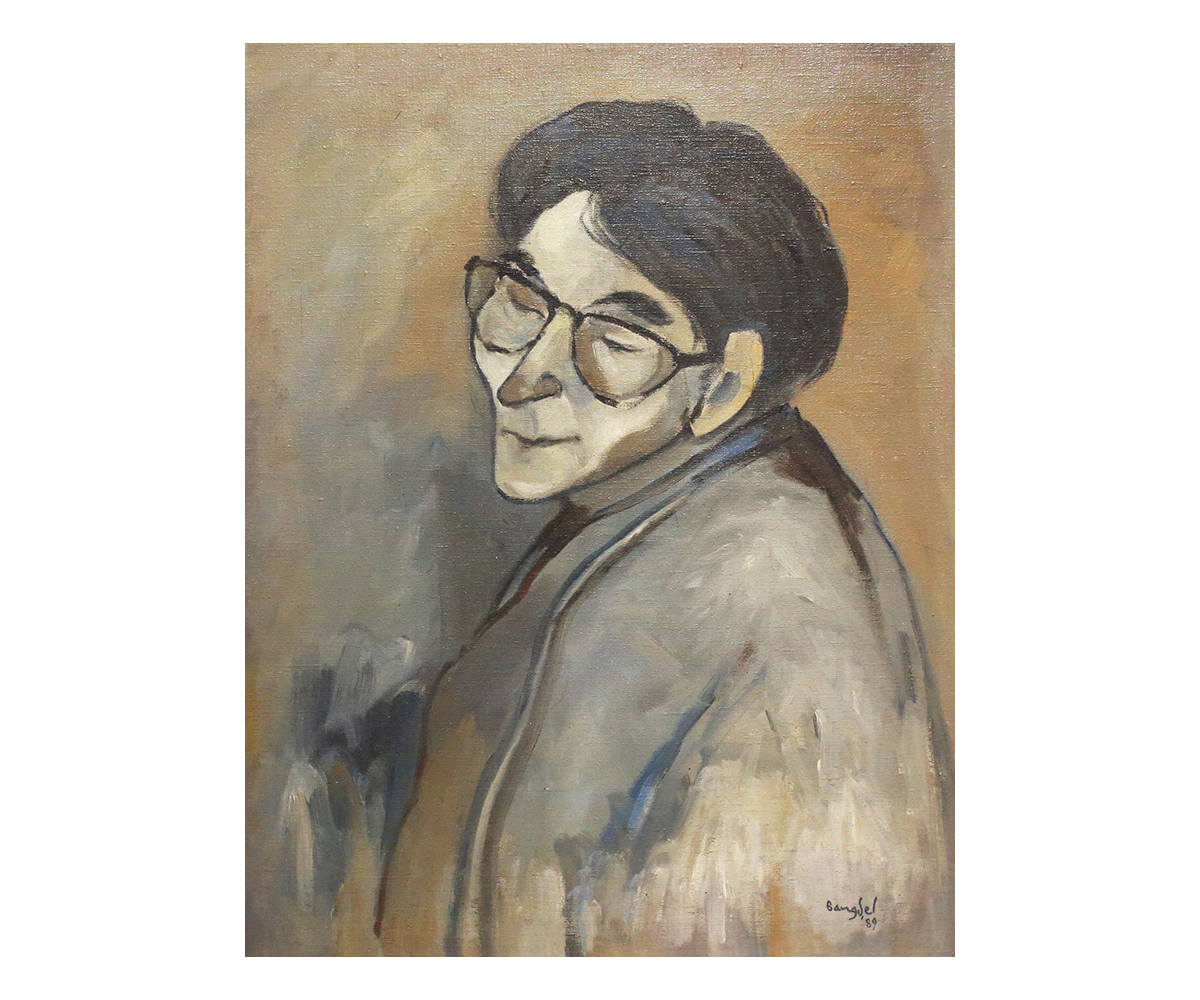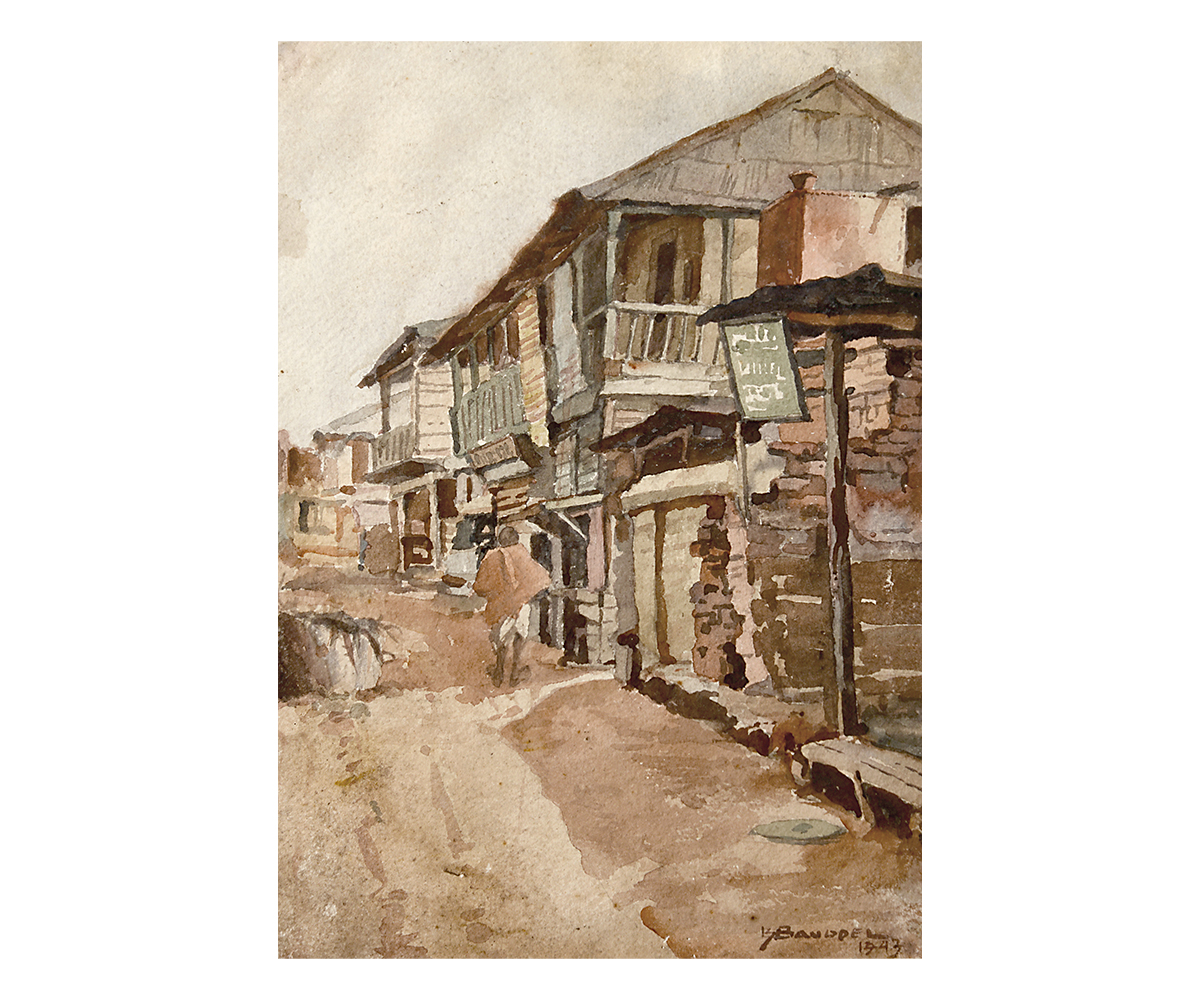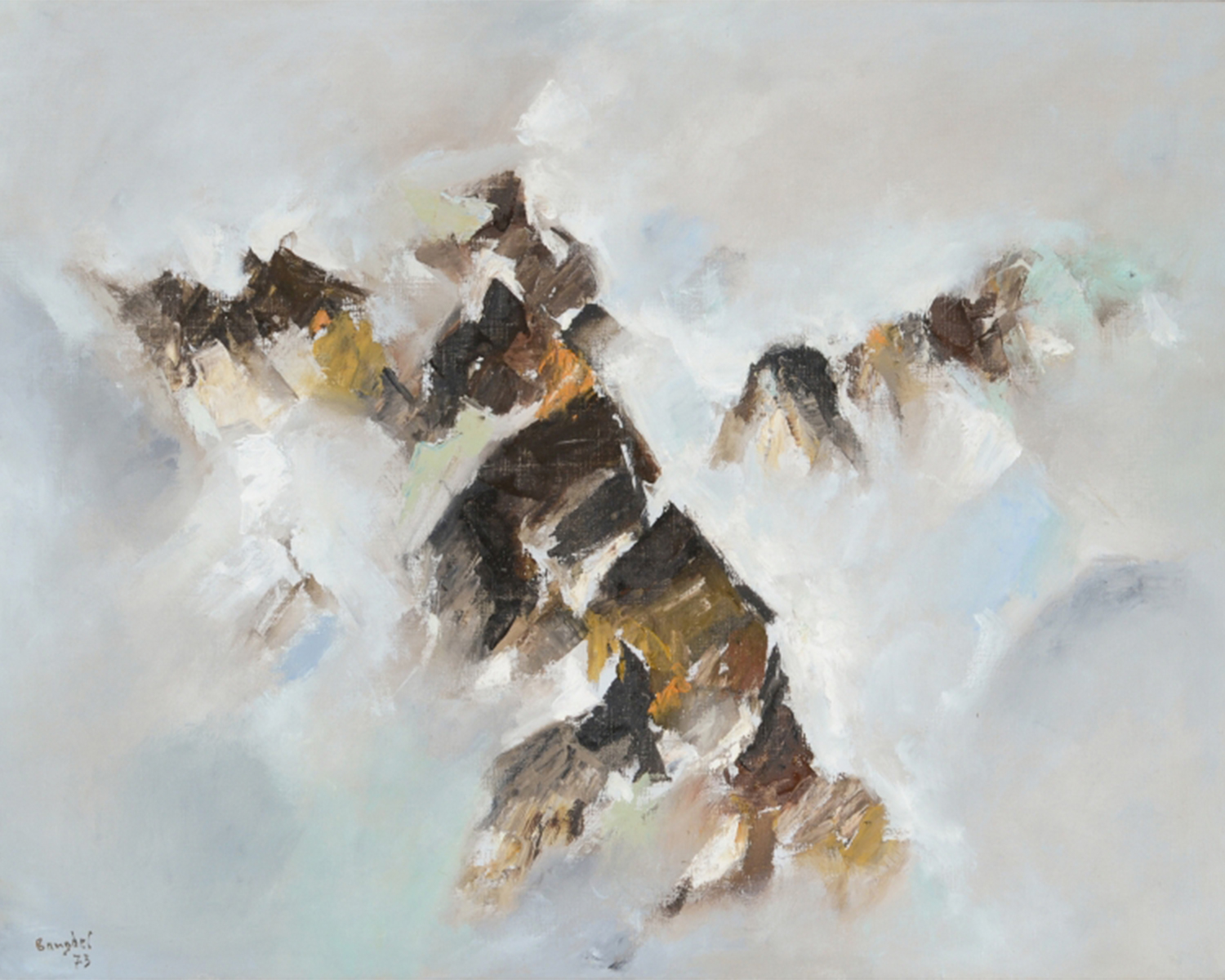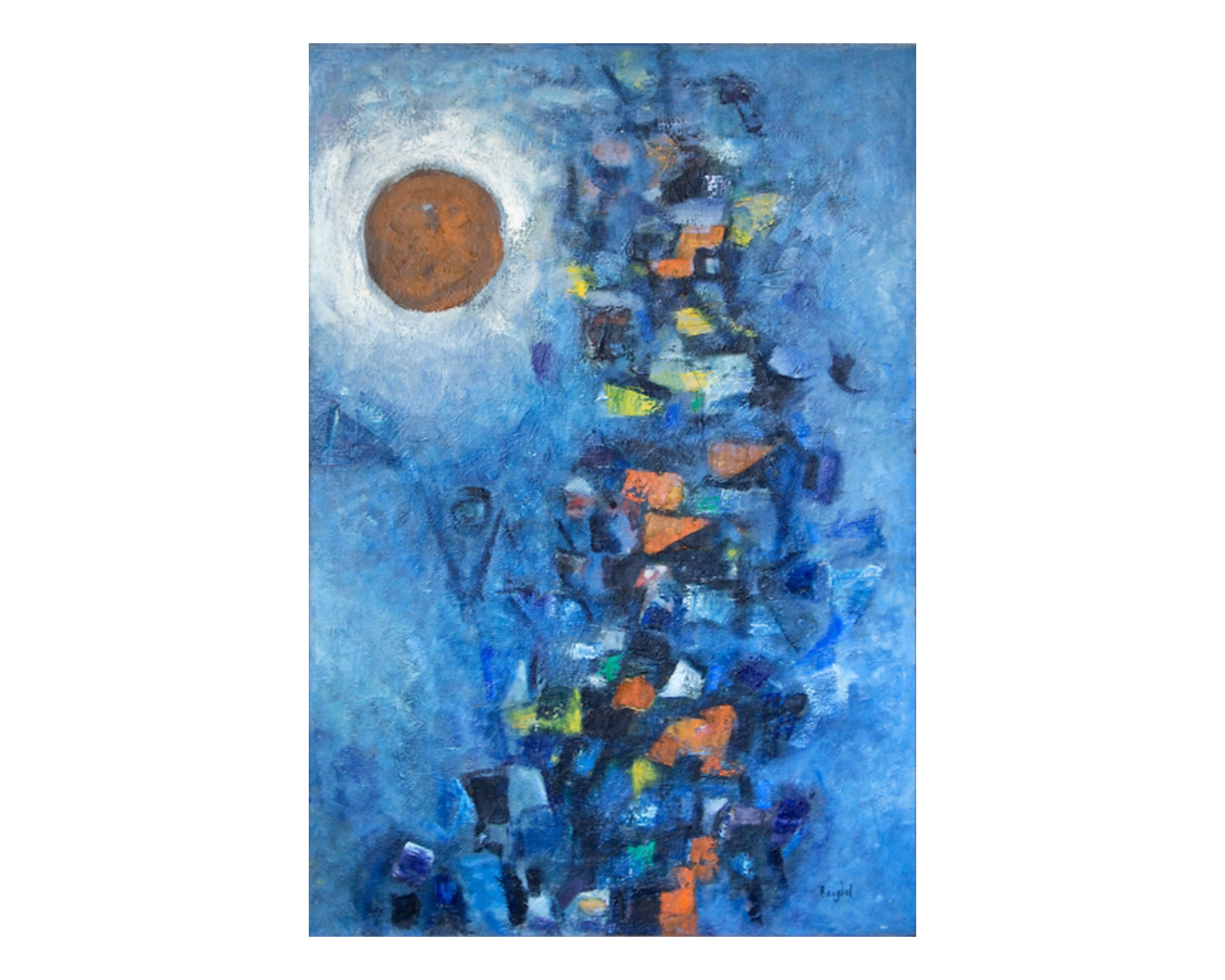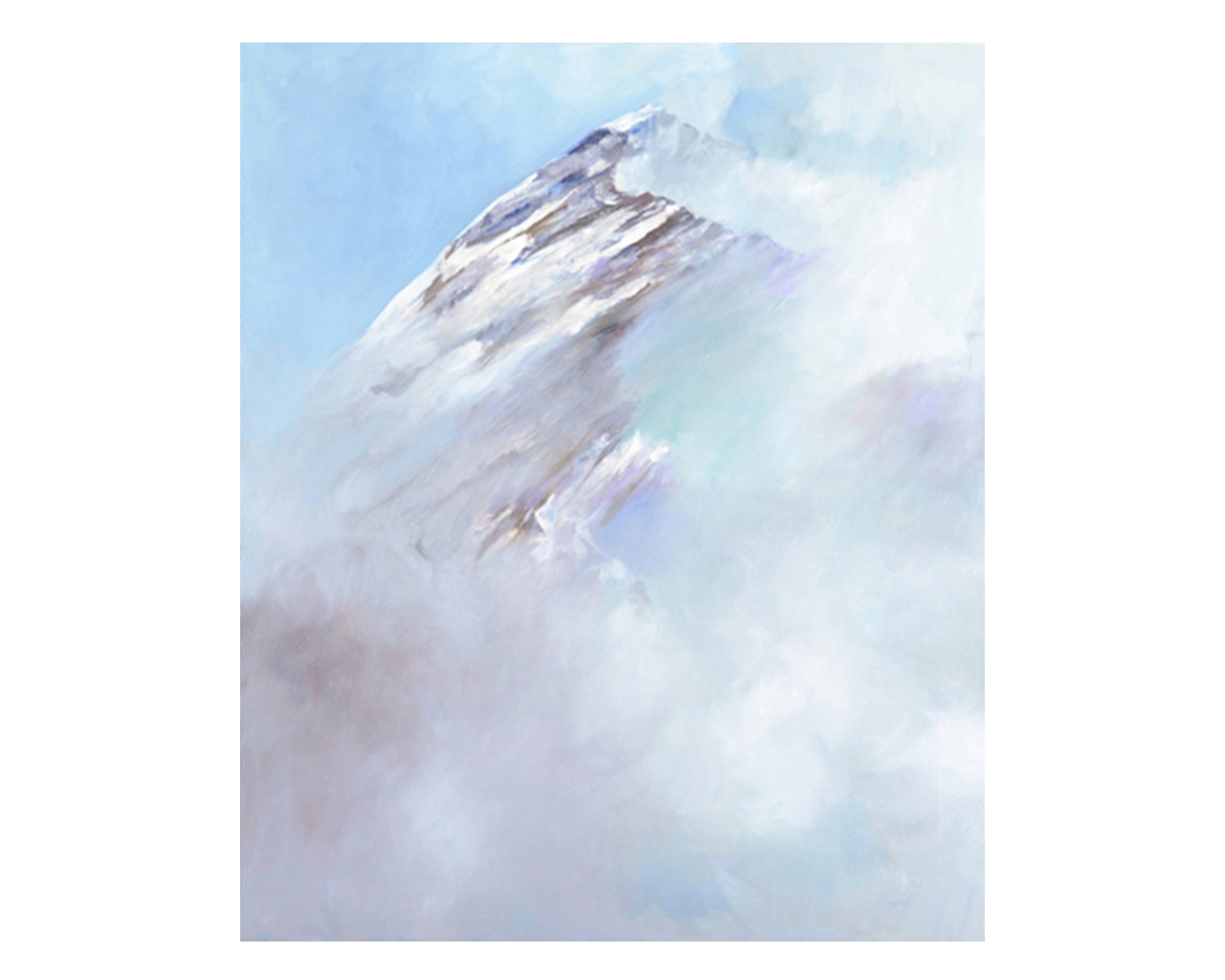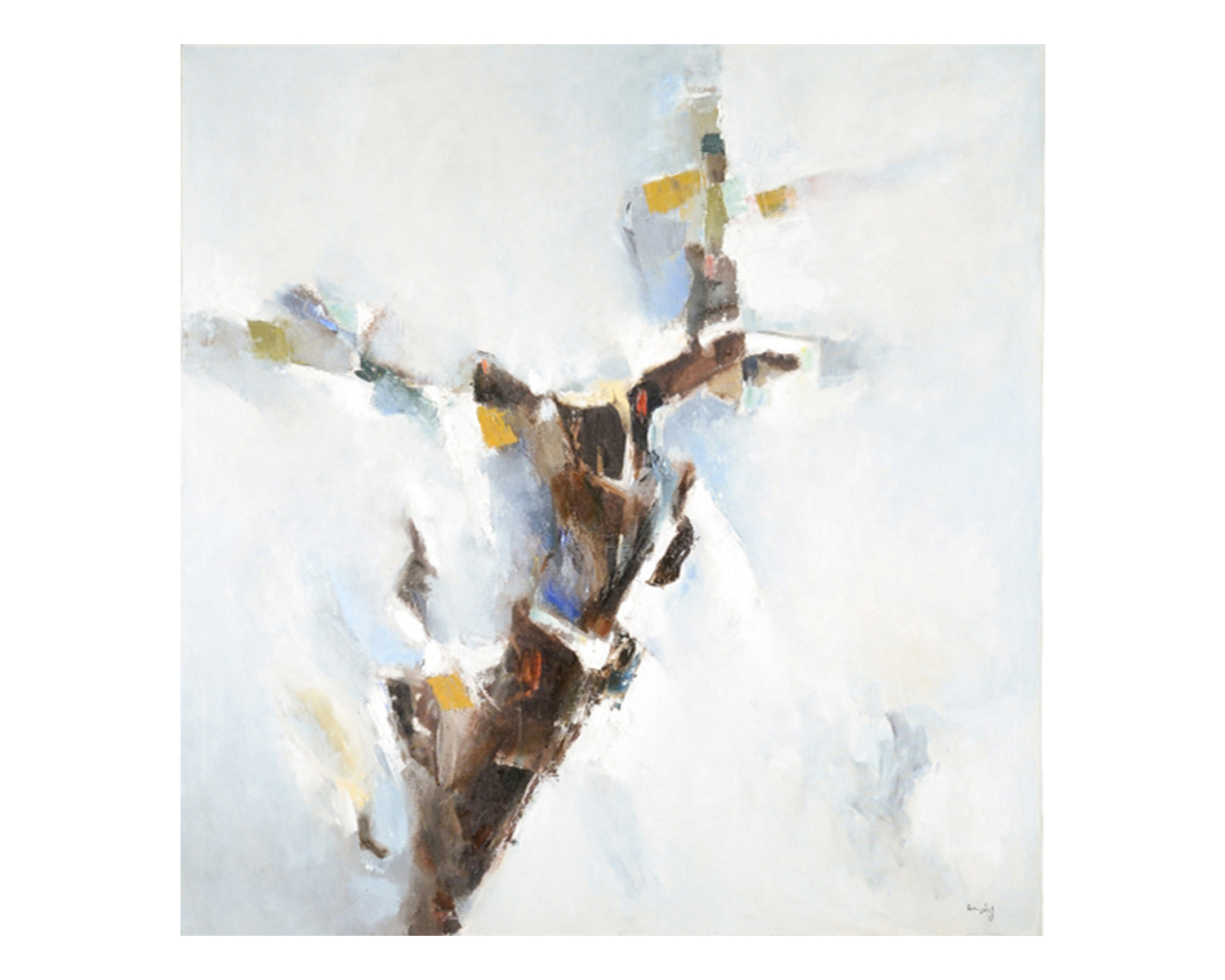ARTICLE
Lain Singh Bangdel (b. 1919; d. 2002)
An art historian, critic, novelist and painter, Lain Singh Bangdel is considered one of Nepal’s pioneering Modernists. Drawing on artistic influences that he encountered during a decade-long stay in Europe, Bangdel’s work explores aspects of Nepali identity and social struggle. Achieving initial recognition for his novels rooted in social realism, he was instrumental in mentoring Nepal’s move towards artistic Modernism and is also known for his scholarly works on the country’s sculptural heritage. As a painter he is recognised for his Abstract Expressionism, characterised by his broad and angular brushstrokes and striking use of colour. His oeuvre encompasses works in oil paint, gouache, watercolour and ink, whose subjects range from cityscapes and Himalayan landscapes to figurative imagery centred on the working class and shaped by the sociopolitical events that he experienced in Bengal and Nepal.
Bangdel was born in 1919 in a village on the outskirts of Darjeeling, in present-day West Bengal, to immigrant parents from the Rai community of eastern Nepal. His father was employed at a tea estate there, initially as a labourer and later as a clerk. Though raised in India, Bangdel identified as a Nepali and remained connected with the Nepali diaspora in Darjeeling. In one of his earliest exposures to art, at the age of eight he encountered the work of Jean-Baptiste-Camille Corot, Jean-Francois Millet and other French painters on postcards that his father once received from a tea estate manager. He later identified these images of landscapes and toiling peasants as a definitive influence that nurtured his fascination with modern French painting and social realism. In 1939, Bangdel enrolled at the Government College of Art and Craft in Calcutta (now Kolkata), where he studied under Zainul Abedin, who would become a pioneering Modernist of present-day Bangladesh.
Like Abedin, Bangdel’s experience of Calcutta in the 1940s was conditioned by events such as the Partition of Bengal and the Bengal famine, which found their way into paintings such as Famine of Bengal (1956–59) (produced while he was in Paris) and novels such as Langada’s Friend (1951), based on the life of an impoverished and disabled beggar. It was also in Calcutta that Bangdel came to be acquainted with other figures associated with India’s Modernist movement such as Jamini Roy, Amrita Sher-Gil, members of the Tagore family in Shantiniketan, and the filmmaker Satyajit Ray, with whom he briefly worked at the advertising agency DJ Keymer. He also published two other novels during this period.
In 1952, Bangdel travelled to England and moved to France soon after to study at the Ecole nationale supérieure des Beaux-Arts (National School of Fine Arts), Paris. Living abroad, he came into contact with other members of the diaspora who would play significant roles in establishing Modernist movements in their own countries, such as Indian artists FN Souza, SH Raza, Akbar Padamsee, MF Husain and Paritosh Sen, as well as the Indonesian artist Affandi and the Austrian artist Soshana Afroyim. His encounters here with pioneering Cubists Pablo Picasso and Georges Braque would shape Bangdel’s own style. In Paris, he also met members of the French intelligentsia such as Andre Malraux, Francois Mauriac, Jean Cocteau and Albert Camus. Bangdel’s interactions with other Modernists and his years in Calcutta, Paris and London (where he moved in 1957) played a role not only in the development of his style but also in his fascination with urban landscapes. It was also here that he was able to reflect on his initial training and association with the traditionalist Bengal School.
Bangdel moved to Nepal in 1961 at the invitation of the nation’s monarch, King Mahendra. He had also been urged to do so in the preceding years by Nepal’s then-prime minister BP Koirala, who was his longtime friend. While Bangdel wished to experience his ethnic homeland, King Mahendra hoped the artist would spearhead Nepal’s cultural transformation to a modern state. He held his first solo exhibition in Kathmandu the following year, which marked the country’s first Modernist art show. Bangdel had arrived in the midst of a dynamic political climate, in which the Rana dynasty’s totalitarianism and isolationist policies were being replaced by attempts at democratic politics and modernisation. Though he had begun to develop close relationships with various Nepali leaders during his time in Europe, and later contributed as a graphic designer to some of the king’s campaigns, he did not affiliate himself to any particular party. Later, throughout Nepal’s increasing shift towards a more Hindu form of government, Bangdel maintained his secular credentials, rarely taking on religious subjects and themes in his paintings.
Upon his arrival in the country, Bangdel had joined the Nepal Academy, a state-supported institution founded a few years previously to promote Nepal’s literature, art and culture. Serving as its chancellor from 1979 to 1989, he undertook studies into Nepal’s cultural heritage. He documented the history of Buddhist and Hindu sculpture in the country and identified works of art that had been looted from Nepal. His research culminated in the books Early Sculpture of Nepal (1982), 2500 Years of Nepalese Art (1985), Stolen Images of Nepal (1989) and Inventory of Stone Sculptures of the Kathmandu Valley (1991). The latter two publications continue to serve as resources for the identification and repatriation of Nepal’s art and artefacts from various parts of the world. In the late 1960s, Bangdel also taught art history for a year at Denison University, Ohio as a Fulbright scholar.
Bangdel’s early paintings, following his move from Darjeeling to Calcutta, show a realist approach and a preoccupation with the city, as in Suburb of Calcutta (1943), a watercolour rendering of densely built ramshackle housing. During his time in Europe, he continued to explore cityscapes and tap into his experience of Bengal, now incorporating the Cubist and Expressionist influences of artists such as Picasso and Braque. While works such as Full Moon Night (1952) show a distorted geometric cityscape in a relatively vibrant palette, the subjects and tonal choices in Old Man and Stupa (1956), Bengal Famine (1955–59) and Muna Madan (1959), evoke those of Picasso’s melancholic Blue Period works. Bengal Famine, painted in a style reminiscent of his previous mentor Abedin, depicts the grief of a mother holding a child she has lost; while Muna Madan (1959), based on the eponymous Nepali love poem written by Laxmi Prasad Devkota in 1936, shows the moment before the protagonist couple is separated as one of them must migrate for work.
As his work moved progressively towards greater abstraction in the 1960s and 1970s, Bangdel’s subjects turned towards the Himalayan landscape. A significant impression from his early life, these mountains and valleys also functioned as a signifier for his Nepali identity. One of his best known works is Moon Over Kathmandu (1962), an vividly coloured abstract oil painting of the Kathmandu Valley, in which some critics have interpreted a suggestion of the Nepali flag. In Kathmandu Valley (1973), loose, dynamic brushstrokes indicate the capital nestled within an undefined expanse of mountainous slopes, while Mt Everest’s West Side (1994) is a closer impression of the partially visible peak in a composition largely filled by sky and clouds. Works such as Abstract II (1969), Bolt and Vortex (1969) and Orange Composition (1976), show Bangdel’s experiments with completely non-representational art, comprising dynamic lines or shapes amidst large, almost flat areas of colour.
He returned to social concerns and partially representational painting with the Expressionist work Struggle for Democracy (1991). Here his energetic brushstrokes create powerful areas of colour foregrounded by agitating figures, capturing the political tumult and dynamism of Nepal’s 1990 Jana Andolan (‘People’s Movement’) for democracy.
Exhibiting little during his career — one solo show in Nepal and three in Europe — Bangdel was much better known as a literary figure, scholar and art historian. Despite this, Bangdel is credited with establishing a Modernist current in Nepali painting alongside other artists such as Tej Bahadur Chitrakar, Chandraman Singh Maksey and Gehendra Man Amatya. He also established Nepal’s first institute for modern and contemporary art, the Nepal Art Council, as well as its gallery. He fostered young artists and collectives such as SKIB-71, whose exhibition catalogues he also occasionally contributed essays to.
Two retrospectives of his paintings have been held, the first organised by the Nepal Art Council in 1991–92, and the second a posthumous exhibition titled Moon Over Kathmandu held at Yeh Art Gallery, New York and Asia Society Texas in the United States. A biography of Bangdel titled The Glory of Nepal (2003) was written by Narendraraja Prasai, and another titled Against the Current (2004) by Donald Alan Messerschmidt and Bangdel’s daughter Dina Bangdel.
Bangdel was awarded the Birendra Gold Medal in 1965 and the Gorkha Dakshin Bahu II by the King of Nepal in 1982. In 1966, Bangdel was awarded the Dulichand Gold Medal from India for his contribution to literature. He was conferred with the title of ‘Commendatore’ by the Italian Government (1985), National Order of Arts and Letters by the Republic of France (1985), and declared a Knight Commander of Royal Victorian Order (KCVO) by Great Britain (1986) for his contributions to the field of the arts.
Bangdel died in Nepal in 2002.
Bibliography
Duffy, Owen. “Moon over Kathmandu: Reflections on Lain Singh Bangdel’s Art for Modern Nepal.” St. John’s University, 2022. Published in conjunction with the exhibition Lain Singh Bangdel: Moon over Kathmandu, presented by New York: Yeh Art Gallery, January 27 – April 9, 2022.
Hagy, Kathryn. “Between Yesterday and Today: Contemporary Art in Nepal.” The ASIANetwork Exchange: A Journal for Asian Studies in the Liberal Arts 19 no. 1 (Fall 2011): 30–41
Manandhar, Raju. “Reinterpretation of Traditional Motifs in Contemporary Nepali Paintings.” M.Phil thesis, Tribhuvan University, 2010.
Sijapati, Alisha. “Lain Singh Bangdel’s Legacy Lives On.” Nepali Times, November 7, 2020. Accessed December 26, 2023. https://nepalitimes.com/here-now/lain-singh-bangdel-s-legacy-lives-on.
Bajracharya, Srizu. “Remembering Lain Singh Bangdel.” The Kathmandu Post, last updated November 21, 2021. Accessed December 26, 2023. https://kathmandupost.com/art-culture/2021/11/18/remembering-lain-singh-bangdel.
Cheng, Sherry. “Moon over Kathmandu: Lain Singh Bangdel at Asia Society Texas Center.” Arts and Culture Texas, December 17, 2022. Accessed December 26, 2023 http://artsandculturetx.com/moon-over-kathmandu-lain-singh-bangdel-at-asia-society-texas-center/.
Yeh Art Gallery. “Lain Singh Bandel: Moon over Kathmandu.” Accessed December 26, 2023. https://sjuartgallery.org/Lain-Singh-Bangdel-Moon-over-Kathmandu.




